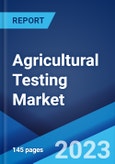Agriculture testing refers to the technique of measuring contaminant content and quality of water, seed, and soil. It is used for analyzing suitable resources and inputs, such as composition, moisture, soil fertility, acidity, and pH level, required to facilitate optimum crop yield. Agriculture testing includes bio-solid, manure, seed, soil and water testing, which primarily characterizes the fertility level and evaluates analytical water quality for irrigation. This, in turn, is assisting farmers, municipalities, and environmental agencies in selecting suitable fertilizers for enhancing crop production, quality, profitability, and nutrient availability across a field.
Agricultural Testing Market Trends:
One of the key factors driving the global agriculture testing market growth is the increasing demand for agricultural products on account of rapid population expansion, urbanization, and industrialization, particularly in emerging economies. Agriculture testing ensures crops are made through genetic engineering, while maintaining the quality of ingredients. Additionally, the increasing outbreaks of various foodborne illnesses, including reactive arthritis, cancer, kidney and liver failure, and brain and neural disorders are facilitating the adoption of agriculture testing across the globe. Besides this, the increasing instances of improper disposal of untreated industrial wastes into the environment have prompted governments of various nations to perform periodical soil testing, which, in turn, is aiding in enhancing the safety and quality of agricultural commodities, Moreover, various technological advancements, such as the integration of the Internet of Things (IoT) and artificial intelligence (AI), to provide real-time insights into the remotely located, insufficiently treated fields are providing an impetus to the market growth. Apart from this, extensive research and development (R&D) activities, along with the establishment of well-equipped laboratories to effectively test samples and commercialize farming, are creating a positive outlook for the market.Market Segmentation:
This report provides an analysis of the key trends in each segment of the global agricultural testing market, along with forecasts at the global, regional, and country levels from 2025-2033. The market has been categorized based on sample, technology, and application.Breakup by Sample:
- Water
- Soil
- Seed
- Biosolids
- Manure
- Others
Breakup by Technology:
- Conventional
- Rapid
- Others
Breakup by Application:
- Safety Testing
- Quality Assurance
- Others
Breakup by Region:
- North America
- United States
- Canada
- Asia-Pacific
- China
- Japan
- India
- South Korea
- Australia
- Indonesia
- Others
- Europe
- Germany
- France
- United Kingdom
- Italy
- Spain
- Russia
- Others
- Latin America
- Brazil
- Mexico
- Others
- Middle East and Africa
Competitive Landscape:
The competitive landscape of the industry has also been examined along with the profiles of the key players being Agilent Technologies Inc., ALS Limited, bioMérieux SA, Bureau Veritas SA, Element Materials Technology, Eurofins Scientific, Intertek Group PLC, Merck KGaA, R J Hill Laboratories Limited, Scientific Certification Systems Inc., SGS S.A. and TUV Nord Group.Key Questions Answered in This Report
1. How big is the agricultural testing market?2. What is the future outlook of the agricultural testing market?
3. What are the key factors driving the agricultural testing market?
4. Which region accounts for the largest agricultural testing market share?
5. Which are the leading companies in the global agricultural testing market?
Table of Contents
Companies Mentioned
- Agilent Technologies Inc.
- ALS Limited
- bioMérieux SA
- Bureau Veritas SA
- Element Materials Technology
- Eurofins Scientific
- Intertek Group PLC
- Merck KGaA
- R J Hill Laboratories Limited
- Scientific Certification Systems Inc.
- SGS S.A. and TUV Nord Group.
Table Information
| Report Attribute | Details |
|---|---|
| No. of Pages | 149 |
| Published | May 2025 |
| Forecast Period | 2024 - 2033 |
| Estimated Market Value ( USD | $ 6.11 Billion |
| Forecasted Market Value ( USD | $ 8.91 Billion |
| Compound Annual Growth Rate | 4.3% |
| Regions Covered | Global |
| No. of Companies Mentioned | 11 |









